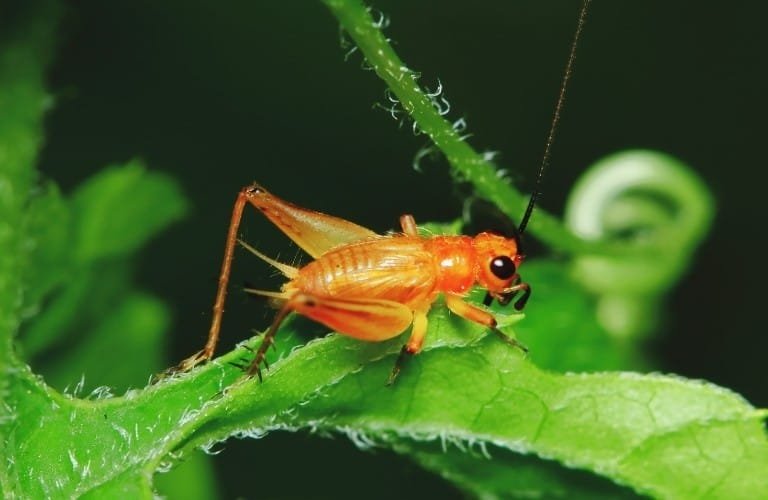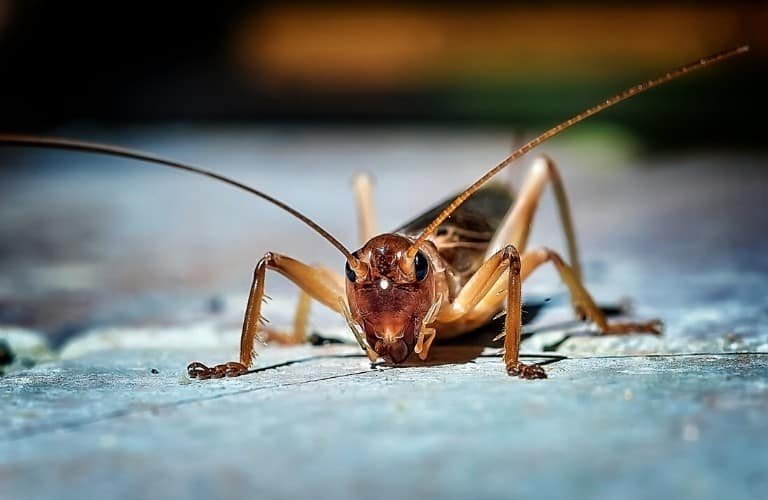When you spot crickets gathering in or around your home, it may make you wonder what’s attracting them.
Critters don’t just show up for no reason. There’s usually some kind of food that’s attracting them.
What do crickets eat? Crickets will eat almost anything, although they prefer plants. They’ll eat freshly planted seeds, sprouting seedlings, and full-grown plants. If food sources are limited, they’ll eat injured or dead insects. Indoors, they’ll eat fabric, wood, and paper products.
Let’s take a closer look at what they eat so you can make your home and yard less desirable for them.
Don’t miss out on important prevention tips and elimination guidelines. Click here to see all of our cricket articles.
Cricket Diet
Crickets are omnivores that prefer to eat plants or decaying matter. They only choose meat sources if they don’t have many other options.
Their diets in the wild and in your home aren’t all that different. Ultimately, crickets will eat almost anything to stay alive.
What Crickets Eat in the Wild
Plants
Plants that crickets will eat include:
- Living plants.
- Decaying plants.
- Freshly planted seeds.
- New seedlings.
Crickets are an annoying pest for farmers and gardeners because they burrow in the ground to live and eat up fresh seeds and young plants.
They’ll even eat the established plants if there isn’t any new growth available.
Insects
If plant material is limited, crickets will eat the following:
- Injured insects.
- Dead insects.
- Grasshopper eggs.
- Pupae of butterflies, flies, and moths.
Crickets won’t eat insects unless they think it’s necessary. The dark part of it is that they’ll even eat their own kind too. They only go for the ones that are dying or dead, however.
Decaying Organic Matter
If something is decaying, crickets will eat it. This includes:
- Plants.
- Animals.
- Wood.
Compost piles are attractive to crickets because they’re an endless supply of food. Piles of leaves, grass, or wood are ideal places to live too.
If you have any kind of decaying material in your yard, keep it away from your house, and keep it covered if you’re able to do so.
What Crickets Eat in Your House
If crickets eat it outside, they’ll eat it inside your home too. Keeping your home tidy is the number one way to keep crickets at bay.
Meat
There’s more opportunity to find small pieces of meat inside of a home. The meats they’ll eat include:
- Dropped pieces of chicken, beef, etc.
- Dead insects.
- Injured insects.
Many homes are prone to have roaches and spiders. (Learn how to eliminate roaches here and fight spider infestations here.)
When these pests die, they become the perfect snack for crickets.
If food is dropped from the table and hangs around for too long, they’ll be sure to find that too.
Plants
Houseplant lovers need to keep a sharp eye out for crickets because they can chew up plants’ roots and stems.
Since indoor plants are usually kept by windows, they’re easy for crickets to find since they’re so close to entry points.
They’ll also go for fruits and vegetables that get dropped on the ground.
If you have crickets in the kitchen, give the kitchen some extra cleaning to make sure there isn’t anything left for them to eat.
Pet Food
The kibble you feed to your dogs, cats, and rodents will also feed crickets since pet food is typically a well-balanced mix of protein and plants.
If you have a cricket problem, it’s best to keep food bags off the floor and away from where you tend to spot the crickets.
Paper
Although it’s not preferred, crickets will eat paper products if they have no other options. Paper things they’ll eat include:
- Pieces of paper.
- Books.
- Cardboard.
- Wallpaper.
Expect to see paper damage in basements and attics that have crickets but a limited supply of other insects.
Fabric
Crickets will eat plant-based fabrics in times of need too, including:
- Cotton.
- Silk.
- Wool.
If you have to store clothing in a place that’s prone to cricket infestations, seal them in airtight containers (these are ideal because they snap shut securely).
Crickets won’t eat synthetic fibers, so those items should be safe.
Are Crickets Harmful to Your Home?
Crickets are harmful to your home, but they can be considered a low-risk pest.
Since plants are their first choice for lunch and insects are their second choice, everything else inside your home will only be eaten in a worst-case scenario.
If there aren’t food scraps or insects available, that’s when they’ll turn to the nearest paper, wood, or fabric item they can find.
Crickets can carry diseases, but they can’t be passed to humans. However, animals can get sick if they eat a diseased cricket, so keep an eye on your cat and reptiles.
Crickets can bite (surprised? – check out this article for more details), but they rarely break the skin because their jaws don’t have the power to do so.
Although they can’t transmit diseases to humans, humans can still experience flu symptoms if the cricket breaks the skin.
They’re not a major threat, but you should contact your doctor if symptoms get worse.
Are Crickets Harmful to Your Plants?
Crickets are incredibly harmful to plants. Since they eat seeds, seedlings, and roots, they can destroy a plant before it ever has a chance to grow.
Houseplants are pretty safe unless you have them sitting on the ground near the crickets’ hiding place.
Even then, tall pots are difficult for crickets to get into. You should still stay cautious if you notice crickets hanging around your plants.
Gardens, on the other hand, are definitely at risk. Crickets burrow in the ground and will eat seeds and roots that make their way into the burrow.
They’ll eat plants as they search for food above ground. Many people use simple, effective DIY traps to help protect their outdoor plants.
Follow the steps found here to try them for yourself.
Crickets can actually be an effective form of weed control, but they don’t discriminate – the plants you want to keep will be gone too.
Confused as to whether you’re dealing with a spider cricket, a camel cricket, a greenhouse cricket, or something else? We clear up the confusion here.
Tips for Keeping Crickets Away
It’s wise to repel crickets before you ever see them so you don’t have to deal with them chewing up your property.
If you’re already overrun with these chirping bugs, visit our complete guide “How To Get Rid of Crickets” for elimination strategies.
Repelling these hungry insects is pretty easy, and you can do it with natural methods that are safe to use inside and outside your home.
- Remove debris: Remove piles of wood, leaves, and grass clippings. If you want to keep them for composting, keep them as far away from your house as possible.
- Seal cracks in your home: Cracks around doors, windows, foundation, and bricks are all entry points for crickets. If you notice an open spot, seal it up.
- LED lights: Crickets are drawn to many types of light except for LED lights. Use these lights on your porch to reduce the number drawn to your door.
- Aromatic plants: Crickets love plants, but they hate the smell of many aromatic foods like garlic and onions. If plants add a lot of nitrogen to the soil or have a strong scent, they’ll probably keep crickets away.
- Essential oils: Crickets hate the smell of rosemary, cloves, and peppermint. Use these oils around your home to deter crickets from wanting to enter or purchase a ready-to-use natural spray that contains these scents, like this peppermint spray.
| Preview | Product | Rating | |
|---|---|---|---|

|
CINOTON 26W LED Wall Pack Light with Dusk to Dawn... | Check Price on Amazon | |

|
Mighty Mint - 16oz Spider Repellent Peppermint Oil... | Check Price on Amazon |
Discover the most effective ways to keep crickets away in our article “Best Cricket Repellent.”
Final Thoughts
Crickets will eat almost anything. They favor plants and will destroy crops, flowerbeds, and gardens, but they’ll also eat dying insects, wood, paper, and fabric.
Removing as many food sources as possible is a guaranteed way to lower the population of crickets around your home.
Keep in mind that they’ll eat cardboard and decaying material, which makes compost piles and gardens irresistible.




